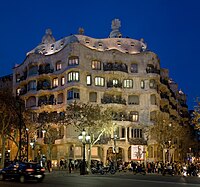
The Eixample is a district of Barcelona between the old city and what were once surrounding small towns, constructed in the 19th and early 20th centuries. Its population was 262,000 at the last census (2005).

Passeig de Gràcia is one of the major avenues in Barcelona (Catalonia) and one of its most important shopping and business areas, containing several of the city's most celebrated pieces of architecture. It is located in the central part of Eixample, stretching from Plaça Catalunya to Carrer Gran de Gràcia.

Gran Via de les Corts Catalanes, more simply known as Gran Via[ˈɡɾam ˈbi.ə], is one of Barcelona's major avenues. With a length of 13.1 km (8.1 mi), it is the longest street in Catalonia and the 2nd longest in Spain, after Gran Vía de la Manga, in La Manga del Mar Menor, but is the one with most street numbers in Spain.

Carrer de Balmes, named after the Catalan philosopher and ecclesiastic Jaume Balmes, is one of the most important avenues in Barcelona. It was devised in 1859 as part of Ildefons Cerdà urban plan.

Avinguda Diagonal is the name of one of Barcelona's broadest and most important avenues. It cuts the city in two, diagonally with respect to the grid pattern of the surrounding streets, hence the name.
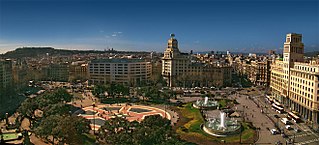
Plaça de Catalunya is a large square in central Barcelona that is generally considered to be both its city centre and the place where the old city and the 19th century-built Eixample meet.
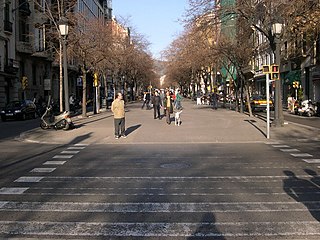
Rambla de Catalunya is a major street in the Eixample district of central Barcelona. It is one of the city's trendiest streets, with many international fashion shops, and is lined with lime trees.

Passeig de Sant Joan is a major avenue in the Eixample and Gràcia districts of Barcelona. It was named after an older street carrying this name, also known as Passeig Nou, built in 1795 around the glacis of the Ciutadella fortress.

Passeig de Lluís Companys is a promenade in the Ciutat Vella and Eixample districts of Barcelona, Catalonia, Spain, and can be seen as an extension of Passeig de Sant Joan. It was named after President Lluís Companys, who was executed in 1940. It starts in Arc de Triomf and ends in Parc de la Ciutadella, on Carrer de Pujades.

Plaça d'Espanya is one of Barcelona's most important squares, built on the occasion of the 1929 Barcelona International Exposition, held at the foot of Montjuïc, in the Sants-Montjuïc district.

Plaça de Lesseps is a square serving as the border between the Sarrià-Sant Gervasi and Gràcia district of Barcelona, Catalonia, Spain, loosely divided in two parts. One of the most heavily transited squares in the city, Lesseps is the starting point of one of Barcelona's busiest rondes: Ronda del General Mitre, as well as being the west end of Carrer Gran de Gràcia and being crossed by a number of streets, namely: Travessera de Dalt, Avinguda del Príncep d'Astúries, Avinguda de Vallcarca, Avinguda de la República Argentina, Carrer del Torrent de l'Olla, Carrer de la Mare de Déu del Coll, Carrer de Santa Perpètua, Carrer de Maignon and Carrer de Pérez Galdós.

Avinguda Tibidabo is a station of the Barcelona Metro and is the terminus of FGC-operated line L7. The station is situated under Carrer de Balmes at Plaça de John F. Kennedy, the former street's junction with the Avinguda Tibidabo and Passeig de Sant Gervasi.
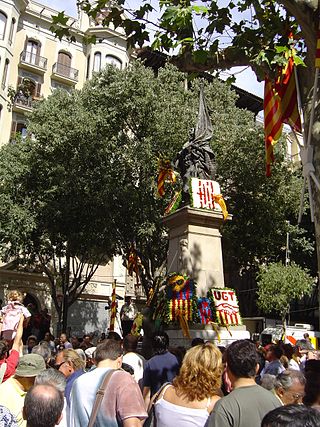
Ronda de Sant Pere is a thoroughfare in central Barcelona, Catalonia, Spain, one of the main roads in the lower side of Dreta de l'Eixample, part of the Eixample district. It runs from the Arc de Triomf, in Passeig de Lluís Companys, through Plaça Urquinaona towards Plaça de Catalunya, where the medieval city walls stood before the construction of Eixample. After Plaça de Catalunya it becomes Ronda de la Universitat.

Carrer del Consell de Cent is a long avenue in Barcelona, Catalonia, Spain. It's one of the horizontal streets of the urban grid that makes up Eixample district, spanning the Esquerra de l'Eixample and the Dreta de l'Eixample quarters, starting at the Parc de Joan Miró by carrer de Vilamarí and ending in the neighbourhood of El Clot, by Avinguda Meridiana, in the Sant Martí district.

Public art in Barcelona is a designated group of monuments and outdoor sculptures in the city. The artworks in city's architecture and network of museums, parks, and gardens, put an artistic stamp on the Catalan capital. Public art in the city developed in the 19th century, although the first municipal commission was the 1673 monument to Saint Eulalia in Pedró Square.
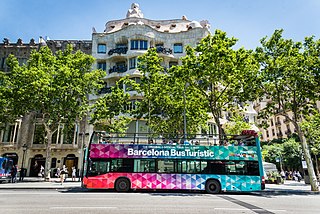
Barcelona Bús Turístic is a tourist bus service in the city of Barcelona, which in 2012 had 3 routes and a fleet of 74 buses. It is managed by the consortium of Turisme de Barcelona and TMB.

The following outline is provided as an overview of and topical guide to Barcelona:


